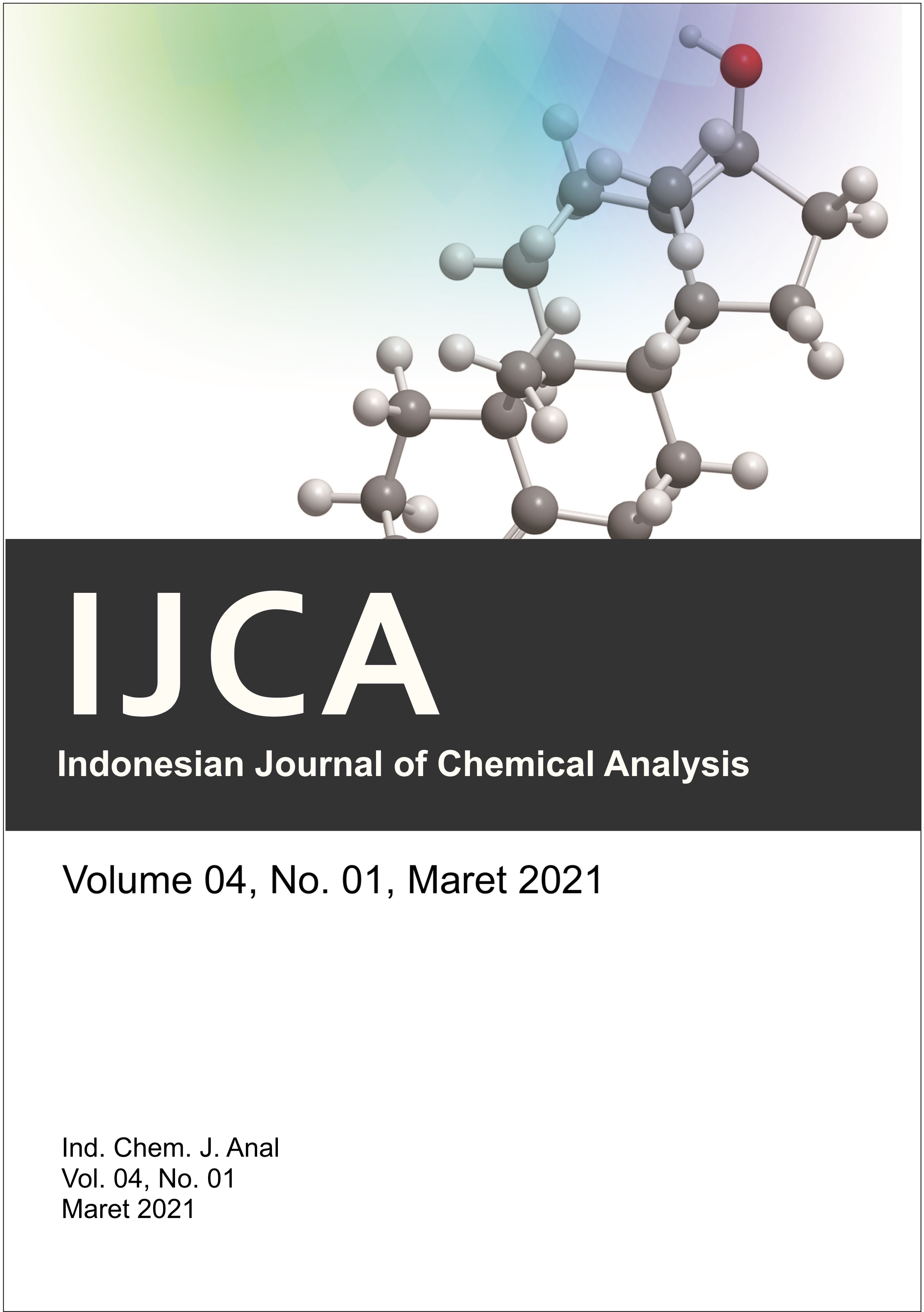Main Article Content
Abstract
Article Details
Copyright (c) 2021 Mieke Alvionita, Rukman hertadi

This work is licensed under a Creative Commons Attribution-ShareAlike 4.0 International License.
You are free to:
Share — copy and redistribute the material in any medium or format
Adapt — remix, transform, and build upon the material for any purpose, even commercially
Under the following terms:
Attribution — You must give appropriate credit, provide a link to the license, and indicate if changes were made. You may do so in any reasonable manner, but not in any way that suggests the licensor endorses you or your use.
ShareAlike — If you remix, transform, or build upon the material, you must distribute your contributions under the same license as the original
No additional restrictions — You may not apply legal terms or technological measures that legally restrict others from doing anything the license permits
References
- Dave, N., Joshi, T. (2017): A Concise Review on Surfactants and Its Significance. International Journal of Applied Chemistry 13(3), 663-672.
- Franca, I.W.L.D., Lima, A.P., …..Goncalves, L.R.B. (2015) : Production of a biosurfactant by Bacillus subtilis ICA56 aiming bioremediation of impacted soils, Catalysis Today 255, 10-15.
- Rufino, R.D., Luna, J.M.D., Takaki, G.M.D.C., Sarubbo, L.A. (2014) : Characterization and properties of the biosurfactant produced by Candida lipolytica UCP 0988, Electronic Journal of Biotechnology 17(1), 34-38.
- Sousa, M.D., Dantas, I.T., Kamilly, A., Felix, N., Ana, B.D.S., Maria, V., … Gonçalves, B. (2014) : Crude Glycerol from Biodiesel Industry as Substrate for Biosurfactant Production by Bacillus subtilis ATCC 6633, Brazilian Archives of Biology and Technology 57, 295–301.
- Santos, D.K.F., Resende, A.H.M., Almeida, D.G.D., …….Sarubbo, L.A. (2017) : Candida lipolytica UCP0988 Biosurfactant: Potential as a Bioremediation Agent and in Formulating a Commercial Related Product, Frontiers in Microbiology 8, 767.
- Geetha S.J., Banat, I.M., Joshic, S.J. (2018): Biosurfactants: Production and potential applications in microbial enhanced oil recovery (MEOR), Biocatalysis and Agricultural Biotechnology 14, 23-32.
- Phulpoto, I.A., Jakhrani, B.A., Phulpoto, A.H., Panhyar, A.A., Kanhar, N.A., Ahmed, S., Qazi, M.A. (2020) : Enhanced Oil Recovery by Potential Biosurfactant Producing Halo thermotolerant Bacteria Using Soil Washing and Sand Packed Glass Column Techniques, Current Microbiology 77(11).
- Gudiña, E.J., Fernandes, E.C., Rodrigues, A.I., Teixeira, J.A., Rodrigues, L.R. (2015) : Biosurfactant production by Bacillus subtilis using corn steep liquor as culture medium, Frontiers in Microbiology 6, 59.
- Mounira, A., Abdelhadi, G. (2015) : Assessment of four different methods for selecting biosurfactant producing extremely halophilic bacteria, African Journal of Biotechnology 14(21), 1764–1772.
- Vreeland, R.H., Litchfield, C.D., Martin, S.E.L., Elliot, E. (1980) : Halomonas elongata, a New Genus and Species of Extremely, International Journal of Systematic Bacteriology 30(2), 485–495.
- Roeßler, M. dan Müller, V. (2002) : Chloride, a New Environmental Signal Molecule Involved in Gene Regulation in a Moderately Halophilic Bacterium, Halobacillus halophilus, Journal Bacteriology 184(22), 6207-6215.
- Maneerat, S. (2005) : Production of biosurfactants using substrates from renewable-resources, Songklanakarin Journal Science and Technology 27(3), 675-683.
References
Dave, N., Joshi, T. (2017): A Concise Review on Surfactants and Its Significance. International Journal of Applied Chemistry 13(3), 663-672.
Franca, I.W.L.D., Lima, A.P., …..Goncalves, L.R.B. (2015) : Production of a biosurfactant by Bacillus subtilis ICA56 aiming bioremediation of impacted soils, Catalysis Today 255, 10-15.
Rufino, R.D., Luna, J.M.D., Takaki, G.M.D.C., Sarubbo, L.A. (2014) : Characterization and properties of the biosurfactant produced by Candida lipolytica UCP 0988, Electronic Journal of Biotechnology 17(1), 34-38.
Sousa, M.D., Dantas, I.T., Kamilly, A., Felix, N., Ana, B.D.S., Maria, V., … Gonçalves, B. (2014) : Crude Glycerol from Biodiesel Industry as Substrate for Biosurfactant Production by Bacillus subtilis ATCC 6633, Brazilian Archives of Biology and Technology 57, 295–301.
Santos, D.K.F., Resende, A.H.M., Almeida, D.G.D., …….Sarubbo, L.A. (2017) : Candida lipolytica UCP0988 Biosurfactant: Potential as a Bioremediation Agent and in Formulating a Commercial Related Product, Frontiers in Microbiology 8, 767.
Geetha S.J., Banat, I.M., Joshic, S.J. (2018): Biosurfactants: Production and potential applications in microbial enhanced oil recovery (MEOR), Biocatalysis and Agricultural Biotechnology 14, 23-32.
Phulpoto, I.A., Jakhrani, B.A., Phulpoto, A.H., Panhyar, A.A., Kanhar, N.A., Ahmed, S., Qazi, M.A. (2020) : Enhanced Oil Recovery by Potential Biosurfactant Producing Halo thermotolerant Bacteria Using Soil Washing and Sand Packed Glass Column Techniques, Current Microbiology 77(11).
Gudiña, E.J., Fernandes, E.C., Rodrigues, A.I., Teixeira, J.A., Rodrigues, L.R. (2015) : Biosurfactant production by Bacillus subtilis using corn steep liquor as culture medium, Frontiers in Microbiology 6, 59.
Mounira, A., Abdelhadi, G. (2015) : Assessment of four different methods for selecting biosurfactant producing extremely halophilic bacteria, African Journal of Biotechnology 14(21), 1764–1772.
Vreeland, R.H., Litchfield, C.D., Martin, S.E.L., Elliot, E. (1980) : Halomonas elongata, a New Genus and Species of Extremely, International Journal of Systematic Bacteriology 30(2), 485–495.
Roeßler, M. dan Müller, V. (2002) : Chloride, a New Environmental Signal Molecule Involved in Gene Regulation in a Moderately Halophilic Bacterium, Halobacillus halophilus, Journal Bacteriology 184(22), 6207-6215.
Maneerat, S. (2005) : Production of biosurfactants using substrates from renewable-resources, Songklanakarin Journal Science and Technology 27(3), 675-683.




